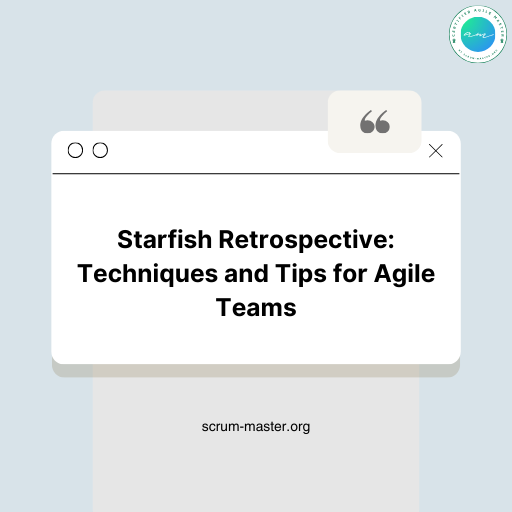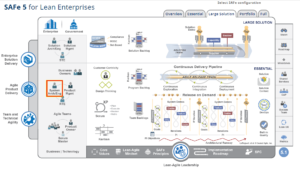In the realm of project management, especially within the Agile methodology, the imperative to manage risk efficiently cannot be overstated. Effective risk management is a cornerstone of project success, particularly in dynamic environments such as those found in Scaled Agile Framework (SAFe) organizations.
Among the various risk management approaches, the ROAM model stands out as a key tool for Agile teams. This model provides a structured system of accountability for risk management, enabling teams to identify and prioritize risks with precision. The ROAM matrix, a key component of the ROAM risk management model, offers a simplified yet powerful approach to categorize risks and devise strategies to mitigate them.
In this article, we delve into the essence of the ROAM matrix, exploring its utility in fostering effective risk management within SAFe Agile Release Trains. We will elucidate how implementing a simple risk management model like ROAM can bolster your Agile project management efforts, ensuring that risks are effectively planned for and managed across various levels of your Agile organization.
Index
- 1 What is the ROAM Matrix?
- 2 How and when to implement the ROAM matrix in an SAFe train?
- 3 Risk management on Jira for an SAFe train
- 4 The benefits of the ROAM matrix
- 5 Training: The ultimate guide to agility (Scrum / Kanban / Lean) and preparation for PSM / CSM / SAFe certifications
- 6 Conclusion
- 7 Suggested Reading
What is the ROAM Matrix?
The ROAM matrix is more than a tool; it’s a cornerstone in the risk management model utilized extensively within the Agile methodology. At its core, ROAM stands for Resolved, Owned, Accepted, and Mitigated. These categories help Agile teams and organizations navigate the complexities of risk management by offering a structured approach to identify and prioritize risks.
- Resolved risks are those that have been completely addressed and no longer pose a threat to the project’s success.
- Owned risks are identified with a specific individual or team tasked with their management, although a comprehensive plan may not yet be in place.
- Accepted risks are those that, after thorough evaluation, are understood and acknowledged by all stakeholders with no immediate plans for mitigation due to constraints or strategic decisions.
- Mitigated risks have detailed plans and actions set to reduce their impact or likelihood, ensuring they are managed proactively.
Understanding the ROAM model is essential for anyone involved in project management, especially within Agile projects. It simplifies the complex landscape of potential risks, making it accessible for both seasoned practitioners and those new to Agile. By categorizing risks, the ROAM matrix provides a clear framework for effective risk management, essential for the success of any Agile project.

How and when to implement the ROAM matrix in an SAFe train?
The ROAM matrix emerges as a fundamental tool for risk management within the Scaled Agile Framework (SAFe), offering a structured approach to identifying, assessing, and addressing risks. But the question arises: how do we practically apply the ROAM matrix, and when is its application most beneficial?
During the PI Planning stage of a SAFe train, the ROAM matrix becomes instrumental. This phase is critical for mapping out the path of user stories and features that development teams will advance in the upcoming Program Increment (PI). Here, the ROAM matrix aids in pinpointing and scrutinizing potential risks and challenges that might impede progress.
To facilitate this process, teams can utilize either a traditional physical board or digital platforms like Miro, Draft.io, or Jira, making the ROAM matrix accessible and interactive.
Here’s a step-by-step guide for teams during PI Planning:
- Identify risks by compiling a comprehensive list with inputs from all team members. This inclusive approach ensures that a wide array of perspectives and potential risks are considered from the outset.
- Assess, rank, and prioritize risks using the ROAM matrix. After identification, the next step involves a collaborative evaluation with team and train members, alongside relevant stakeholders. This assessment hinges on determining the impact and likelihood of each risk, followed by strategizing on mitigation measures.
- Assign a carrier for each risk, ensuring there’s a clear responsibility for ongoing management and resolution.
After PI Planning:
- Acting on priority risks: Post-PI Planning, the focus shifts to action. The designated risk owner is tasked with formulating a detailed action plan to address the prioritized risks, a process that unfolds throughout the Sprint cycles.
- Follow-up: Regular synchronization meetings, such as the SAFe Coach Sync or the PO Sync, serve as checkpoints to monitor and discuss the status of risk management efforts initiated during PI Planning.
In essence, the ROAM matrix stands as an effective mechanism for risk management within a SAFe train, particularly highlighted during the PI Planning stage. By adhering to the outlined steps, teams can engage in a thorough and collaborative process to assess, rank, and prioritize risks. This collective effort plays a crucial role in mitigating risks, thereby enhancing the overall performance and success of the SAFe train.
Template for the ROAM risk management matrix of a SAFe Train during PI Planning on a Miro board.
Risk management on Jira for an SAFe train
Jira has become an indispensable Agile tool for many organizations, and its utility extends into the realm of risk management. For teams operating within a Scaled Agile Framework, Jira offers a flexible platform to manage risk and categorize risks effectively, leveraging the principles of the ROAM matrix.
To implement ROAM risk management on Jira, teams can start by creating a dedicated project or Kanban board. This board should feature columns corresponding to the ROAM categories, facilitating the organization and tracking of risks as they move from identification through to resolution.
The integration of the ROAM matrix into Jira allows for real-time visibility and management of risks. Each risk can be detailed with comprehensive information, including its title, description, impact, priority, and assigned owner. This level of detail ensures that all team members have access to the information they need to take appropriate action, fostering a proactive approach to risk management.
Training and documentation are also crucial steps in leveraging Jira for ROAM risk management. By educating the Agile team on the importance of accurately completing each risk’s fields and the overall process, organizations can maximize the effectiveness of their risk management efforts.
Using Jira in this way transforms it from a simple project management tool into a dynamic platform for managing risks within the Agile Release Train, enhancing the Agile methodology with robust risk management capabilities.

The benefits of the ROAM matrix
The ROAM matrix offers several key advantages for risk management that are vital for any organization employing the Agile or SAFe methodologies. These benefits streamline the process of identifying, assessing, and addressing risks, ensuring that projects remain on track and objectives are met with minimal disruptions.
Simplicity: The ROAM matrix’s straightforward design makes it an accessible tool for teams across all levels of experience. Its clear categorization of risks into Resolved, Owned, Accepted, and Mitigated simplifies the assessment and ranking process, making it an efficient method for managing project risks.
Visibility: By offering a comprehensive view of all identified risks, along with their potential impacts and the strategies planned to address them, the ROAM matrix enhances the transparency of the risk management process. This visibility is crucial for informed decision-making and fosters a proactive approach to risk management.
Prioritization: One of the most critical aspects of risk management is knowing which risks require immediate attention. The ROAM matrix facilitates this by allowing teams to prioritize risks based on their likelihood and impact. This ensures that resources are allocated effectively, focusing on mitigating the most significant risks first.
Responsibility: Assigning clear ownership of risks is vital for accountability and follow-through. The ROAM matrix does this effectively, designating specific individuals or teams to manage each risk. This clarity helps ensure that risks are addressed promptly and efficiently, with progress easily tracked and managed.
By harnessing these advantages, teams can enhance their risk management efforts, making the ROAM matrix an invaluable tool in the arsenal of any Agile or SAFe organization.
Conclusion
The ROAM matrix stands as a beacon in the domain of risk management, providing a streamlined and impactful method for navigating the complexities of risks in projects and organizational activities. It empowers teams to effectively assess, classify, and manage risks, ensuring that they can be prioritized, addressed, and monitored with precision. The essence of using the ROAM matrix lies in its ability to facilitate clear assignment of responsibilities and the implementation of targeted actions to mitigate risks. For sustained success in risk management, it is imperative to engage in regular review and adjustment of strategies based on the evolving landscape of identified risks. This dynamic approach ensures the resilience and adaptability of your projects or business operations, safeguarding against potential setbacks and optimizing outcomes.
Suggested Reading
For those eager to explore further into the realms of risk management and the ROAM matrix, the following books offer invaluable insights and practical guidance:
“The Standard for Risk Management in Portfolios, Programs, and Projects” by the Project Management Institute. This comprehensive guide delves into the intricacies of risk management within various project contexts, offering readers a wealth of practical examples and advice for establishing a robust risk management framework. It also explores the ROAM matrix among other essential tools, making it an essential resource for professionals seeking to enhance their risk management capabilities.
“Agile Enterprise Risk Management: Risk-based Thinking, Multi-disciplinary Management and Digital Transformation” by Howard M. Wiener. This book provides a thorough examination of the core principles, tools, and techniques essential for mastering risk management. Focusing on agile methodologies, it presents a multidisciplinary approach to navigating risks in the digital age, making it a must-read for those looking to adapt risk management practices to contemporary business and technological challenges.








